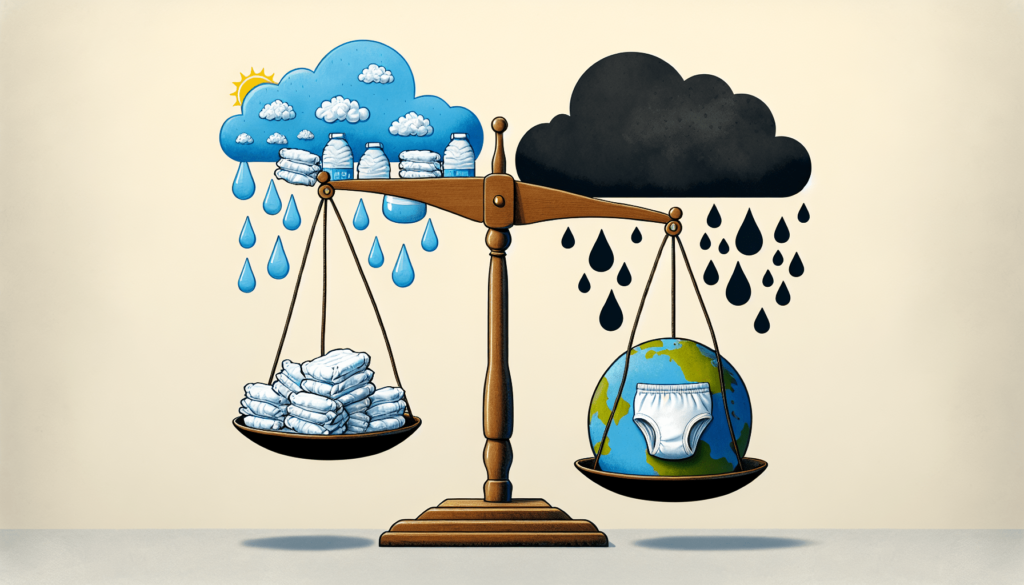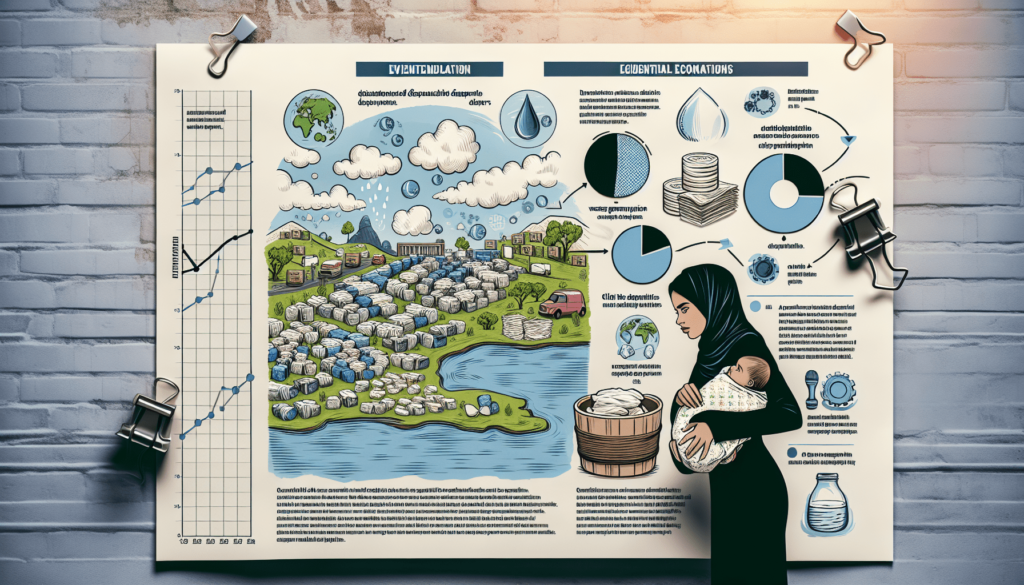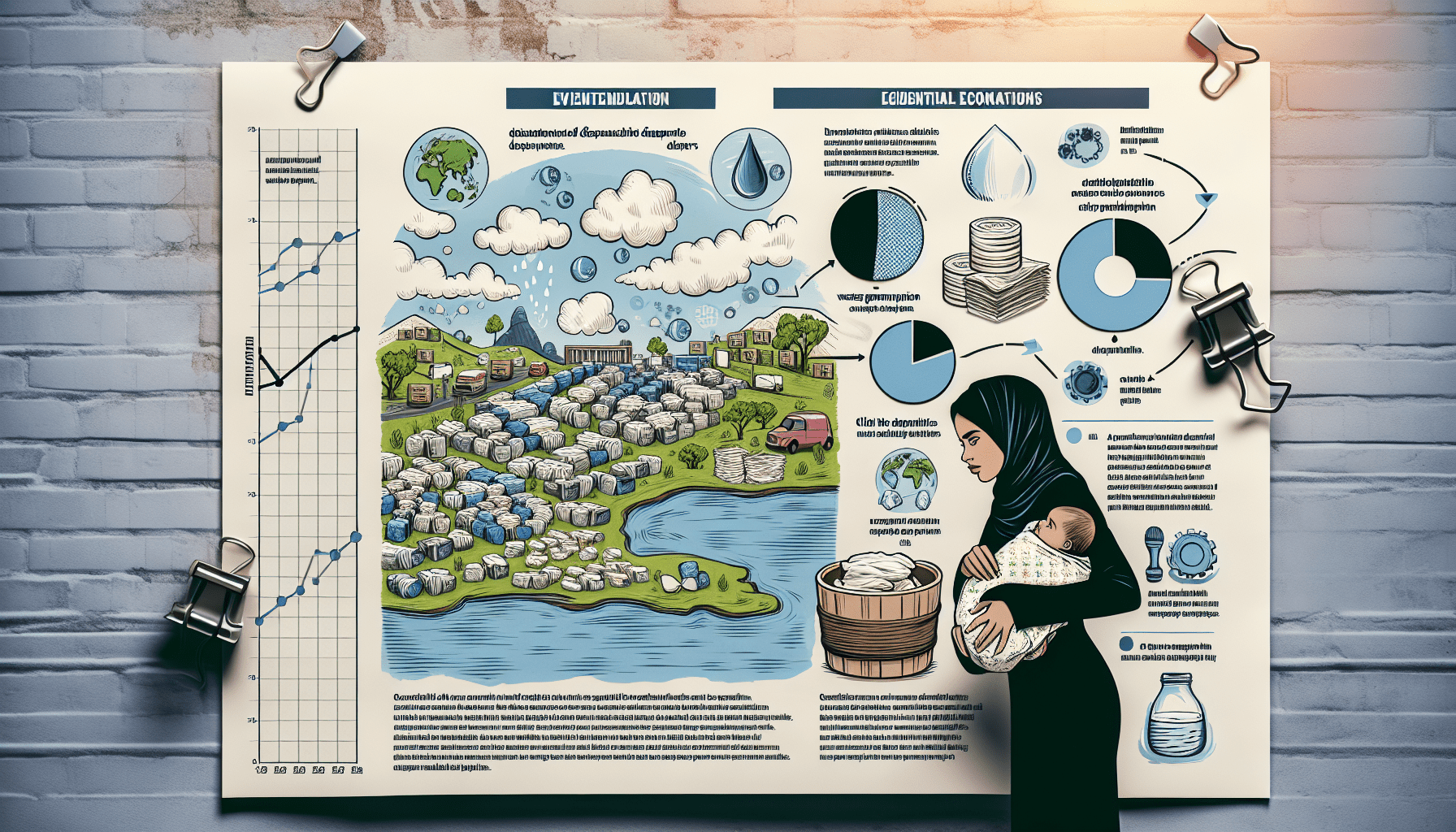Hey, did you know that the impact of disposable diapers on the environment is definitely something we should be talking about? With the rising concerns about waste management and sustainability, it’s important to understand just how our everyday choices can contribute to the overall health of the planet. In this article, we’ll take a closer look at the environmental impact of disposable diapers and explore some alternative options that might help us make more eco-friendly choices for our little ones. So, if you’re interested in learning about how those convenient diapers can impact the environment, stick around and let’s explore together!

1. Introduction
Disposable diapers have become a common choice for parents worldwide due to their convenience and ease of use. However, it is important to consider the environmental impact associated with these single-use products. This article aims to provide an overview of the manufacturing process, landfill waste, water pollution, resource depletion, carbon footprint, health concerns, alternatives, and industry and government initiatives related to disposable diapers.
1.1 Background on disposable diapers
Disposable diapers were first introduced in the 1950s and quickly gained popularity as an alternative to cloth diapers. They are typically made of a combination of synthetic materials, such as polyethylene and polypropylene, along with absorbent materials like wood pulp and superabsorbent polymers.
1.2 Purpose of the article
The purpose of this article is to shed light on the environmental impact of disposable diapers and provide information on alternative options. By understanding the manufacturing process, landfill waste, water pollution, resource depletion, carbon footprint, health concerns, and industry and government initiatives, parents can make informed decisions about diapering methods that have a reduced impact on the environment.
2. Manufacturing Process
2.1 Raw materials used in disposable diapers
Disposable diapers comprise various raw materials, including wood pulp, petroleum-based plastics, and superabsorbent polymers. Wood pulp is obtained from trees through a process called chemical pulping, which involves using chemicals to break down the fibers in the wood. Petroleum-based materials, such as polyethylene and polypropylene, are derived from non-renewable resources.
2.2 Energy consumption during manufacturing
The manufacturing of disposable diapers involves significant energy consumption. The production process includes various stages like material extraction, transportation, and conversion. Each step contributes to the overall energy footprint of the diapers. Energy is required to power the machinery and equipment used in the manufacturing facilities, as well as for transportation during the supply chain.
2.3 Water usage in the manufacturing process
Water is another valuable resource used during the manufacturing process of disposable diapers. It is required for cleaning, cooling, and rinsing purposes. The high water consumption throughout the production cycle puts pressure on local water sources, especially in areas already facing water scarcity. It is crucial for manufacturers to adopt water-saving measures and explore water recycling options.
2.4 Chemicals used in manufacturing
Various chemicals are used in the production of disposable diapers. Some of these include chlorine compounds, phthalates, and dyes. Chlorine compounds are often used in the bleaching of wood pulp, which can result in the release of harmful byproducts, such as dioxins. Phthalates, which are used to make plastics more flexible, have been linked to health concerns. Additionally, dyes used in diapers can contain heavy metals, which may have adverse effects on both human health and the environment.
3. Landfill Waste
3.1 Amount of disposable diapers in landfills
Landfills receive a massive amount of disposable diapers, contributing to the growing waste problem. According to estimates, approximately 20 billion disposable diapers are discarded each year in the United States alone. This significant volume of waste adds to the strain on landfill capacities and resource management systems.
3.2 Decomposition time of disposable diapers
Disposable diapers can take several hundred years to decompose in landfills. The combination of synthetic materials, such as plastic, and the lack of oxygen in landfill conditions slows down the decomposition process significantly. As a result, disposable diapers remain in landfills for an extended period, occupying valuable space and contributing to environmental pollution.
3.3 Methane emissions from landfill disposables
The decomposition of organic matter in landfills, including the absorbent components of disposable diapers, produces methane gas. Methane is a potent greenhouse gas that contributes to climate change. The accumulation of methane in landfills further exacerbates the environmental impact associated with the disposal of disposable diapers.

4. Water Pollution
4.1 Chemicals released into waterways
The chemicals present in disposable diapers can seep into the soil when they reach landfills. Over time, these chemicals can leach into groundwater and nearby water bodies, contributing to water pollution. The compounds released, such as dioxins, phthalates, and heavy metals, pose a threat to aquatic life and ecosystems.
4.2 Impact on aquatic life and ecosystems
The pollution caused by chemicals released from disposable diapers can have detrimental effects on aquatic life and ecosystems. Aquatic organisms, including fish and other marine species, may be exposed to these harmful substances, leading to various health issues. Additionally, the chemicals can disrupt the delicate balance of ecosystems, affecting the biodiversity and overall health of water-based environments.
5. Resource Depletion
5.1 Consumption of wood pulp and petroleum
The production of disposable diapers consumes vast amounts of wood pulp and petroleum-based materials. Wood pulp, derived from trees, is a crucial component in the absorbent core of disposable diapers. The continuous extraction of wood pulp contributes to deforestation and habitat loss. Petroleum, a non-renewable resource, is used in the production of plastics and synthetic materials, further straining global oil reserves.
5.2 Impact on natural resources
The high demand for raw materials in the manufacturing of disposable diapers puts a strain on natural resources. Deforestation leads to the depletion of forest ecosystems, resulting in the loss of biodiversity and habitats for countless plant and animal species. Furthermore, the extraction and processing of petroleum contribute to environmental degradation and pollution.
6. Carbon Footprint
6.1 Carbon emissions during manufacturing
The manufacturing process of disposable diapers emits a significant amount of carbon dioxide (CO2) and other greenhouse gases. The extraction of raw materials, transportation of goods, and the energy required to power manufacturing facilities all contribute to the carbon footprint of disposable diapers. These emissions contribute to global warming and climate change.
6.2 Transportation and distribution emissions
The transportation and distribution of disposable diapers from manufacturing facilities to retail locations and ultimately to consumers also contribute to carbon emissions. The movement of these products over long distances, often by trucks and airplanes, increases fuel consumption and air pollution. Minimizing transportation-related emissions is crucial in reducing the carbon footprint of disposable diapers.
6.3 Impacts on climate change
The carbon emissions associated with the manufacturing, transportation, and disposal of disposable diapers contribute to climate change. The accumulation of greenhouse gases in the atmosphere leads to temperature rise, sea-level rise, and extreme weather events. It is essential to consider the impact of these emissions and seek alternative diapering methods to mitigate climate change.
7. Health Concerns
7.1 Chemical exposure to babies and diaper users
Disposable diapers come into direct contact with a baby’s sensitive skin, potentially exposing them to chemicals present in the diapers. Chemicals like dioxins, phthalates, and chlorine compounds may cause skin irritation or allergies. Long-term exposure to certain chemicals can have negative health effects on infants and diaper users.
7.2 Risk of diaper rash and irritation
Disposable diapers have been associated with an increased risk of diaper rash and skin irritation. The combination of excessive moisture, heat, and chemicals present in diapers can contribute to these common conditions in infants. It is important for parents to be aware of the potential risks and take preventive measures to minimize diaper-related skin issues.
8. Alternatives to Disposable Diapers
8.1 Cloth diapers
Cloth diapers are a reusable alternative to disposable diapers. They can be made from various natural fibers, such as cotton or bamboo, and are available in different styles, including prefolds, fitted diapers, and pocket diapers. Cloth diapers can significantly reduce waste generation and have a lower carbon footprint compared to disposable diapers. They require regular washing, but advancements in cloth diaper technology have made them easier to use and maintain.
8.2 Biodegradable diapers
Biodegradable diapers are another option for environmentally conscious parents. These diapers are made from plant-based materials, such as cornstarch, and are designed to break down more quickly than traditional disposable diapers. While biodegradable diapers may still end up in landfills, they offer a more sustainable alternative to conventional disposable diapers.
8.3 Elimination communication
Elimination communication is a practice where caregivers learn to recognize and respond to their baby’s elimination needs, often from an early age. This method aims to minimize the use of diapers altogether by promoting early toilet training or using baby-friendly potties. Though it requires commitment and patience, elimination communication can significantly reduce diaper waste and environmental impact.
9. Consumer Awareness and Behavior
9.1 Education and information for parents
Consumer awareness and education play a crucial role in promoting sustainable diapering practices. It is important for parents to have access to accurate and comprehensive information about the environmental impact of disposable diapers, as well as alternative options. Providing resources, such as educational materials and workshops, can empower parents to make informed choices and adopt more sustainable diapering practices.
9.2 Behavioral changes for sustainable diapering
Encouraging behavioral changes can further contribute to sustainable diapering practices. Simple actions like reducing diaper changes, using reusable wipes, and opting for environmentally friendly diaper creams can make a difference. Additionally, promoting early potty training and elimination communication can minimize the use of diapers altogether. By adopting these behavioral changes, parents can reduce waste generation and minimize their environmental footprint.
10. Industry and Government Initiatives
10.1 Sustainable manufacturing practices
The diaper manufacturing industry can adopt sustainable practices to mitigate the environmental impact of disposable diapers. This includes exploring alternative materials, improving energy efficiency, implementing water-saving measures, and reducing emissions throughout the supply chain. By embracing sustainable manufacturing practices, companies can reduce their carbon footprint and conserve valuable resources.
10.2 Regulations and policies
Government regulations and policies can also contribute to the shift towards more sustainable diapering practices. Mandatory labeling of disposable diapers, requiring disclosure of materials used and environmental impact, can provide transparency to consumers. Additionally, incentivizing the use of environmentally friendly diapering options through tax breaks or subsidies can encourage parents to choose more sustainable alternatives.
10.3 Recycling initiatives
The diaper manufacturing industry and local governments can collaborate to develop recycling initiatives for disposable diapers. Research and development in recycling technologies can help divert diaper waste from landfills. By implementing effective recycling programs, the industry can reduce landfill waste and minimize the environmental impact associated with disposable diapers.
In conclusion, the widespread use of disposable diapers has significant environmental consequences. From the manufacturing process to landfill waste, water pollution, resource depletion, carbon footprint, and health concerns, the impact of disposable diapers can no longer be ignored. However, through education, consumer awareness, and the adoption of alternatives like cloth diapers, biodegradable diapers, and elimination communication, parents can make a positive difference. Industry and government initiatives that focus on sustainable manufacturing practices, regulations and policies, and recycling can further support a shift towards more environmentally friendly diapering practices. By making conscious choices, we can protect the planet for future generations while ensuring the comfort and well-being of our little ones.

